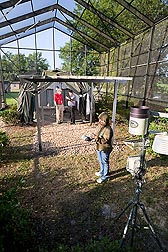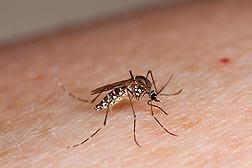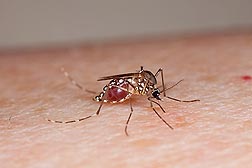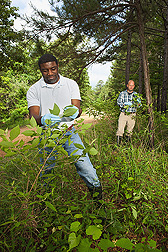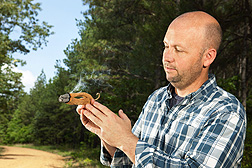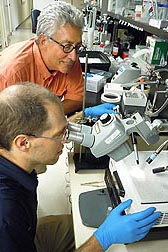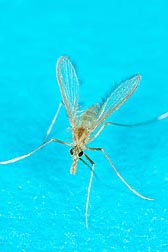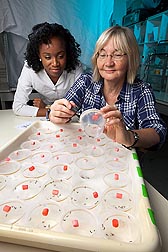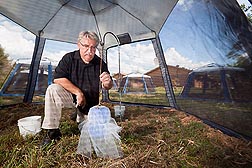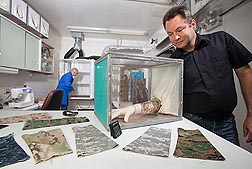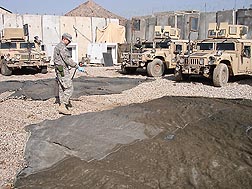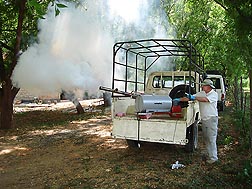DWFP: A Battle Plan To Protect
U.S. Troops From Harmful Insects
During World War II, U.S. Army General Douglas MacArthur was quoted as saying, “It’s going to be a very long war if for every division I have facing the enemy, I have one sick in the hospital and another recovering from this dreadful disease”—meaning malaria. Today, the battle against insects that cause disease is still being fought to help protect deployed U.S. troops and enable them to accomplish their mission.
Mosquitoes, sand flies, ticks, mites, and other biting arthropods transmit pathogens that cause some of the most devastating diseases. Malaria, dengue fever, yellow fever, Japanese encephalitis—all transmitted by mosquitoes—and a host of other diseases affect people around the globe and are a particular problem for militaries that send men and women to places where such illnesses are endemic.
For example, “In 2003, 80 out of 225 U.S. marines deployed on a mission to Liberia came down with malaria, but no deaths were associated with that incident,” says U.S. Air Force Lieutenant Colonel Douglas Burkett, research liaison officer with the Armed Forces Pest Management Board (AFPMB). “The trouble with most widely used insecticides is that we have fewer available active ingredients for public-health pest control, and at the same time, we have a global increase in insecticide resistance to our best chemical tools.”
The mission of the U.S. Department of Agriculture is critical to the U.S. Department of Defense (DOD), Burkett says. The Agricultural Research Service, USDA’s in-house research arm, has excellent research capabilities and is good at developing and testing pesticides and developing application technologies that support public health.
A strong alliance has long existed between USDA and DOD—as far back as 1932, when an entomological research laboratory was established in Orlando, Florida, to combat mosquitoes, filth flies, and disease-transmitting arthropods like fleas and mites.
“It was important to have a laboratory in an area where there were a lot of malaria vectors at that time,” says Ken Linthicum, director of the ARS Center for Medical, Agricultural, and Veterinary Entomology (CMAVE) in Gainesville, Florida. “During World War II, one of the laboratory’s objectives was to determine how to interrupt malaria transmission in the South Pacific to protect soldiers stationed there.”
Today, a new battle plan is under way. The Deployed War-Fighter Protection (DWFP) research program was implemented in 2004 to prevent or defend against insect attacks on troops. USDA receives $3 million of the $5 million allotted to the AFPMB by the U.S. Congress each year for research that focuses on developing public-health insecticides, improving personal protection for troops, and devising improved application technologies to kill insects. Remaining funds are distributed through competitive grants to universities, military laboratories, and private industry.
“Across DWFP, we have built a real strong network not only with the U.S. Department of Defense and the USDA, which is what this partnership is all about, but with universities, industry, and others,” says U.S. Navy Captain Stanton Cope, former AFPMB director and DWFP manager. “When you consider this program has only been in existence for a short period of time, its outreach and productivity are phenomenal.”
In the 1940s, USDA scientists at the Orlando lab, which was later moved to Gainesville and eventually became a part of CMAVE, developed delousing techniques that prevented millions of cases of louse-borne typhus, a disease with a high death rate and no effective treatment at that time. They also created the aerosol spray canister. Other achievements included the discovery of DEET by scientists at the Henry A. Wallace Beltsville Agricultural Research Center in Beltsville, Maryland. Today, DEET remains a primary defense against biting insects.
“DEET is still the best topical repellent we’ve got,” Burkett says. “It has a long safety track record, but some soldiers don’t like the odor and feel, and they prefer to have other options.”
Initially, DWFP funds were to be used to bring together the skills of scientists at different ARS laboratories—starting with basic ideas that would end with registered products. This goal was mostly achieved, says Dan Strickman, ARS national program leader for Veterinary, Medical, and Urban Entomology. The research team includes 15 scientists at 5 ARS laboratories located in Florida, Maryland, Mississippi, and Texas.
“We’re strongest in discovery and have developed entirely new classes of insecticides out of the DWFP program,” Strickman says.
|
|
Unlocking the Chemistries of Folk Remedies
Some of those discoveries have come from plants gathered in the wild and from traditional folk remedies—two methods used by scientists at the Natural Products Utilization Research Unit in Oxford, Mississippi, to find plant-derived compounds to deter insects.
A story about a farmer in the 1930s crushing leaves of the American beautyberry plant and putting them under the harnesses of stock animals to keep pests away led to the discovery, in that plant, of the compound callicarpenal, which has significant repellency against mosquitoes and ticks. (See “Learning From Our Elders: Folk Remedy Yields Mosquito-Thwarting Compound,” Agricultural Research, February 2006.)
Working closely with scientists at the ARS Mosquito and Fly Research Unit in Gainesville, Florida, and with Abbas Ali and others at the National Center for Natural Products Research at the University of Mississippi, chemist Charles Cantrell, plant pathologist David Wedge, and research leader Stephen Duke are exploring additional promising compounds from the American beautyberry and other plants to find natural alternatives that are as effective as or better than DEET at repelling arthropods.
Recently, Cantrell examined mosquito-deterrent effects of callicarpenal and looked at an efficient synthetic approach for commercial companies interested in producing it as an insect repellent.
Following up on a tip about people in Africa and India who burn Jatropha curcas seed oil in lamps to keep insects out of their homes and other areas, researchers identified which of the oil’s components are responsible for mosquito repellency.
In the lab, smoke was extracted from burning J. curcas oil and analyzed. A number of active compounds—free fatty acids and triglycerides—were found to be effective at preventing mosquitoes from biting.
“Fatty acids are well known to have insect repellency,” Cantrell says. “We identified the triglycerides as also having repellent activity, the first such report, to my knowledge.”
Another possible source of repellents is breadfruit, which contains compounds similar to those in Jatropha sp. Cantrell hopes to combine the two sources into a more effective product.
One novel discovery is being kept under wraps for now. Chemist Kumudini Meepagala at the Oxford lab, collaborating with chemist Ulrich Bernier at Gainesville, has developed a natural-product-based mosquito repellent that is more active and lasts three times longer than DEET. A patent application has been filed on this undisclosed compound.
Learning How Repellents Hinder Mosquito Attacks
Another laboratory instrumental to the DWFP program is the Invasive Insect Biocontrol and Behavior Laboratory in Beltsville. Scientists involved in DWFP research there include chemist Kamal Chauhan, entomologist Joseph Dickens, and postdoctoral research associate Jonathan Bohbot. The group develops new chemical tools that are commercially viable and safe for humans, animals, and the environment.
In one study, Bohbot and Dickens sought to determine how the repellents DEET, 2-undecanone, IR3535, and picaridin produce their effects against the yellowfever mosquito. They found that these repellents affect specific odorant receptors in mosquitoes differently—scrambling the insect’s ability to detect chemical attractants like octenol.
“We injected frog eggs with the odorant receptor genes that we’re interested in, and the synthetic machinery within the eggs produced those receptors and put them in the outer cell membrane of the egg,” Dickens explains. “We could then use tiny electrodes placed in the outer cell membrane to record electrical responses resulting from the presence of the odorant receptors.”
The effects of the chemicals were then determined by flushing solutions of odorants or repellents over the eggs.
This cutting-edge technology enabled the Beltsville scientists to make a series of important basic discoveries with potential practical applications. Among those discoveries were the identification of the first mosquito receptor that could distinguish mirror images of molecules and individual proteins that recognize different attractants, and learning the way in which insect repellents scramble messages from chemical attractants.
Dickens says these new findings explain in part how repellents work and may be used to discover or enhance repellents in the future, based on their differential effects on specific odor receptors.
Outmaneuvering Mosquitoes
Much of the DWFP research takes place in the Mosquito and Fly Research Unit at CMAVE, where research leader Gary Clark; entomologists Dan Kline, Jerry Hogsette, Chris Geden, and James Becnel; and Bernier evaluate insecticides in the later stages of development and design innovative technology to fight biting insects and other pests.
Their work includes a rapid screening system for compounds to determine insecticidal possibilities, which was developed by Becnel’s group. A patent was awarded for a molecular pesticide technology that kills mosquitoes by preventing them from producing proteins essential for survival.
Another team member, entomologist Sandra Allan in the Insect Behavior and Biocontrol Research Unit at CMAVE, is using toxic sugar-based baits to lure and kill mosquitoes.
“You put this bait or trap out in the environment, and the mosquitoes or sand flies that want to sugar-feed come and feed on the bait, which contains pesticides that kill them,” Allan says. “That’s really important because mosquitoes and sand flies sugar-feed more often than they blood-feed.”
Only female mosquitoes blood-feed, whereas both males and females need to sugar-feed.
Allan looked at different commercial pesticides that include additives allowing them to be dissolved and ingested in water.
“That’s important because when the mosquito feeds, it’s actually drawing up the pesticide because it’s water soluble,” Allan says. “Also, using registered, commercially formulated pesticides puts us one step closer to developing end products and getting them out into the field.”
In the study, 10 different insecticides were combined with a sucrose solution and fed to females of three mosquito species—Culex quinquefasciatus, which transmits West Nile virus; Anopheles quadrimaculatus, a malaria vector; and Aedes taeniorhynchus, an important pest and vector of some arboviruses.
Compounds from five different classes of insecticide active ingredients—pyrethroids, phenylpyroles, pyrroles, neonicotinoids, and macrocyclic lactones—were toxic to all mosquito species. These compounds could be used to develop toxic baits for the pests, Allan says. The next step is to evaluate these chemicals against sand flies and to determine if one is better than the others.
|
|
New Recruits To Help Fight Sand Flies
Sand flies are another major pest for troops in the Middle East, Afghanistan, and Africa.
“I was one of those guys deployed to Iraq in 2003,” Burkett says. “I’m an entomologist. I know how to control sand flies, because I’ve read all the textbooks. The reality is, when we got there, nothing worked. Soldiers were getting between 100 and 1,000 bites per night from sand flies that were testing positive for the parasites that cause this hideous disease, leishmaniasis.”
There are no vaccines or medications to prevent leishmaniasis, nor any way of telling whether a soldier has it until 3 or 4 months after being bitten by a sand fly infected with Leishmania parasites, Burkett says. Victims of the disease commonly suffer with permanent skin disfigurement and sometimes severe organ damage.
Two years ago, scientists at the ARS Knipling-Bushland U.S. Livestock Insect Research Laboratory inKerrville, Texas, joined the DWFP team to help find ways to kill sand flies. Entomologists Andrew Li, Adalberto Pérez de León, and their colleagues started a sand fly colony to evaluate new insecticides and repellents, develop formulations, and design diagnostic tools for rapid detection of resistance.
“Our project focuses on screening insecticides that are available on the market to see which ones are more effective,” Li says. “The information we gain will be helpful to the military and the public in choosing insecticides to control the sand fly.”
Only a few studies have addressed sand fly resistance to pesticides, so Li is looking at sand fly genes to find answers. He is developing a test for detecting mutations responsible for resistance.
Another laboratory looking for solutions is the ARS European Biological Control Laboratory in Thessaloniki, Greece. With funds from the DWFP program, ARS hired Alexandra Chaskopoulou, a native of Greece and a postdoctoral research associate, who is examining sand fly populations that transmit leishmaniasis in her country.
|
|
Fighting Filth Flies
Nonbiting flies that shuttle between filth and food spread bacteria that cause diarrhea, the most common reason for absence from duty in the U.S. military.
“In my experience in the military, every time there was an outbreak of flies, there was an increase in the disease rate and a big increase in diarrhea,” Strickman says. “When we controlled flies, we brought that down.”
Not to be outflanked, scientists are working with a number of products and techniques that involve testing new traps, finding insecticides that work, and developing new methods to control this nuisance.
CMAVE’s Geden recently teamed with researchers at an Australian public-health agency to determine whether an insect growth regulator called “pyriproxyfen,” which was successful in controlling mosquitoes, could also kill house flies.
“Pyriproxyfen mimics a hormone in the larval fly,” Geden says. “When it’s applied in sufficient quantities to larval breeding sites such as manure, insects become stuck in the immature stages and they never become adults.”
The greatest potential for pyriproxyfen may be via autodissemination, a process in which adult flies are treated with pyriproxyfen that they later transport to egg-laying sites, he says.
Geden treated gravid females—those with eggs—with a dust containing pyriproxyfen and then allowed the flies to lay their eggs on a larval medium. All immature flies died in the pupal stage. This approach would eliminate broadcast application of the insecticide and take advantage of fly behavior to deliver the pyriproxyfen to targeted larval-breeding sites, Geden says. Scientists looked at the dosages required to kill house flies, the potency needed, different formulations, and the amount a fly can carry to the larval habitat.
“We found the material extremely effective at low dosages for house flies and that flies are capable of carrying enough back to their breeding sites to prevent the maturation of immature flies,” Geden says. “We’re now working with new formulations of higher potency to improve this system.”
On a different front, CMAVE’s Hogsette is working with University of Florida scientists to find more effective methods for baiting and trapping flies.
“House flies can use a wide range of larval development media—almost anything that’s moist—and can develop from the egg to the adult stage in just 6-1/2 days,” Hogsette says. “Multiple traps may be required at capture sites to effectively reduce house fly populations, but research is needed to determine just how many are needed.”
What To Wear
Factory-treated uniforms that repel insects are the latest in protective fashion for deployed troops. Attachable bands that offer additional protection may be in style for the future.
“The more proficient we are at repelling or killing insects, the better our ability to prevent disease transmission to our troops when they are deployed,” Bernier says.
Bernier and textile chemist Melynda Perry of the U.S. Army Natick Soldier Systems Center evaluate the quality of permethrin-treated uniforms and fabric. The testing-and-evaluation process is an outcome of efforts made in 2003 by the U.S. Marine Corps to stock combat uniforms that were factory treated with permethrin. The initial specifications to qualify permethrin-treated uniforms were drafted in 2006.
Research on U.S. Army uniforms is conducted by Bernier, Perry, and Neal Nguyen of the Program Executive Officer Soldier at Fort Belvoir, Virginia.
Treated uniforms have been standard practice since 1951, when an ARS-developed miticidal mixture, M-1960, was used. M-1960 was discontinued in 1982 because it was a skin irritant. ARS scientists developed a permethrin treatment of uniforms, and field treatment of cotton uniforms with this repellent became available in 1991.
Since then, new uniforms have been introduced, and many incorporate fire-resistant fibers. Application of permethrin to these uniforms is not possible without factory treatment.
Bernier developed a bite-protection assay to test how well uniforms protect the wearer from mosquito bites. It requires that a human volunteer wear a tightly sewn uniform sleeve and then insert the covered arm into a cage of mosquitoes.
“We use human volunteers because, in the real world, humans wear these uniforms,” Bernier says. “It’s far better to figure out the best treatment here at home, before the uniforms are worn in the field and we end up having missions fail.”
Uniform fabric specimens are tested to determine their ability to provide protection initially and after 20 and 50 launderings. So far, a total of 65 U.S. military uniform constructions and compositions have been evaluated.
In 2011, scientists examined alternative fabrics for potential replacement of the original fire-resistant Army combat uniform. Fabric replacement was necessary because the material initially selected was too easily torn. Earlier this year, Bernier completed bite-protection testing on uniforms constructed of this more durable fire-resistant fabric.
Bernier and chemist Chauhan have created an attachable repellent-treated band that augments the uniform by conferring some spatial protection to exposed skin. Preliminary evaluations indicate that the band may have additional use for travelers against bed bugs, Chauhan says.
“We’ve achieved protection for the uniform, but our ultimate goal is a stand-alone product, so even without the uniform, you can put the band on the sleeve or collar to protect that area for a long period, and it can be used again and again,” Chauhan says.
Chauhan has filed for a patent on another new product—a disposable, reversible bandage—for short-term protection. The invention also has potential application for recreation and sports use and as a device to protect pets and livestock from biting insects.
Rounding Up the Best Equipment
Each year, ARS scientists at the Southern Plains Agricultural Research Center (SPARC) in College Station, Texas, pack up and head off to an equipment rodeo—the Annual International Equipment Evaluation—at the Navy Entomology Center of Excellence (NECE) at Jacksonville Naval Air Station in Florida.
The team from NECE and the SPARC Areawide Pest Management Research Unit’s Aerial Application Technology group “round up” sprayers of all shapes and sizes—hand-held, backpack, truck-mounted, and thermal foggers with water and oil-based sprays and insecticides—used in insect-control applications.
“Manufacturers operate their own equipment, and all testing is done out in the open,” says SPARC agricultural engineer Clint Hoffmann. “The good and bad results are published on all equipment tested.”
So far, the group has developed droplet size spectra for about 88 sprayers.
“We think we’ve tested every piece of equipment that’s in the military arsenal,” Hoffmann says.
“Adding this group of engineers that work with droplets and machinery has given a huge boost to this program,” Burkett says. “They have a lot of expertise for area application sprayers, and they find out what works and what doesn’t, which is a great benefit to the military.”
Scientists use the most accurate measuring tool, a laser diffraction instrument, to measure spray droplet sizes, test active ingredients, and capture data. Studies have led to the development of a user-friendly smartphone application that can be downloaded to help users select spray equipment and optimize spray settings, says agricultural engineer Brad Fritz. (See story on "Spraying Insecticide? There's an App for That!" in this issue for details.)
Taking It to the Field
“Whenever you get a new compound that works well in the laboratory, you have to take it to the field to make sure it’s useful in the real world,” says CMAVE’s Kline.
Spatial repellents are used in field conditions to significantly reduce the number of mosquitoes and other biting insects in a specific area over a certain period of time, he says. The criteria for insecticides depend on the situation.
“For example, the individual soldier may be on sentry duty, not moving,” Kline explains. “Special operations teams may be hiding out, looking for terrorists. Then you may have a community of soldiers in a tent or encampment where dimensions may vary.”
In one experiment, scientists set up tents previously used in Iraq to evaluate how effective different compounds are at protecting an occupant from mosquitoes and stable flies. (See photo above.)
“Many of the applications tested were not practical for soldiers, which is why there’s a need for a better delivery system and one reason why treating uniforms with compounds is critical,” Kline says.
“We go to a desert, like the Coachella Valley in California, that is similar to desert environments in the Middle East where U.S. troops are deployed,” says Linthicum, “and we’re able to evaluate the effectiveness of various equipment and treatment methods.”
Tents, camouflage screening, sun awnings, and other structures of deployed units can be treated quickly using spray equipment currently issued to preventive-medicine units, Linthicum says.
Studies have shown that insecticide treatment of woodland-pattern military camouflage netting is long lasting and effective at reducing mosquitoes. Seth Britch, an entomologist at CMAVE and a captain in the U.S. Army Reserve, demonstrated that desert-pattern camouflage netting can also be treated to provide effective protection against mosquitoes and sand flies in a hot, arid environment.
The study involved spraying specially formulated insecticides onto the netting. Once dry, the residual treatment forms a barrier that is toxic to insects, Britch says.
The material was then packed in a conex cargo container and shipped to Tallil Air Force Base in Iraq, where it was stored for 5 months and then tested from March-June 2010. The netting was sent back to CMAVE for analysis.
“After almost 300 days, we were still getting good control of mosquitoes,” Linthicum says.
In another experiment, Britch, Linthicum, and Todd Walker, an entomologist formerly with NECE, evaluated the performance of ultra-low-volume pesticide spray equipment, chemicals, and techniques in Kenya against sand flies for the first time. They tested two pesticide sprayers and two pesticides against wild and colony-reared sand flies as proxies for similar sand fly species and similar environments found in Iraq and Afghanistan. They demonstrated that current DOD equipment and one pesticide performed well against sand flies in a hot, arid environment.
Getting Products to Troops
Using funds from the DWFP program, ARS and the Interregional Research Project No. 4 (IR-4) signed a cooperative agreement to establish the IR-4 Public Health Pesticides Program to facilitate registration of new uses of chemicals.
“One of the reasons the IR-4 project was brought into the mix is because we have worked in the public sector almost 50 years to provide an avenue to get these minor-use products into the hands of IR-4’s traditional stakeholders—the growers of fruits, vegetables, herbs, and other specialty crops,” says Jerry Baron, executive director of the IR-4 project.
The roles of IR-4 are to make sure insecticides are safe, to work with the U.S. Environmental Protection Agency in getting products registered, and to find active ingredients that already have registrations for other purposes that may have public-health applications, says Karl Malamud-Roam, manager of the IR-4 Public Health Pesticides Program.
“We work hard to maintain registration of existing, useful public-health products and to ensure that the registration process is as smooth and efficient as possible,” Malamud-Roam says.
There are many good ideas in the minds of scientists, military experts, and academic and industry partners, and in chemical libraries, Malamud-Roam says. There’s also a product-development pipeline that sometimes gets clogged.
“IR-4 has traditionally been like a regulatory plumber,” he says. “Our job is not to make discoveries, like new molecules. We leave that to other scientists. Our job is to figure out how to get molecules from the idea stage to product registration.”
More than 330 scientific papers have been published by researchers since the DWFP program began. Most of this research, about 81 percent, is the work of ARS scientists.
“This is what it’s all about,” Burkett says. “This is what keeps programs alive. When funds are put into research programs like DWFP, discoveries are made, collaborations are built, and it actually results in tangible products that we can get into the hands of soldiers to kill bugs.”—By Sandra Avant, Agricultural Research Service Information Staff.
This research is part of Veterinary, Medical, and Urban Entomology, an ARS national program (#104) described at www.nps.ars.usda.gov.
To reach scientists mentioned in this article, contact Sandra Avant, USDA-ARS Information Staff, 5601 Sunnyside Ave., Beltsville, MD 20705-5129; (301) 504-1627.
"DWFP: A Battle Plan To Protect U.S. Troops From Harmful Insects" was published in the November/December 2012 issue of Agricultural Research magazine.








